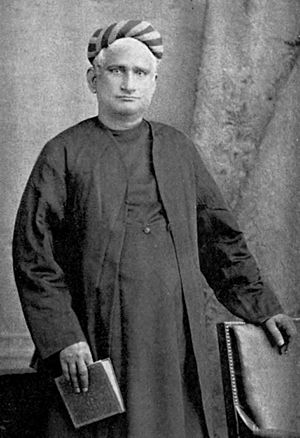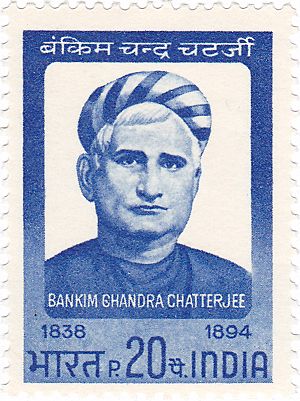Bankim Chandra Chatterjee facts for kids
Quick facts for kids
Bankim Chandra Chatterjee
|
|
|---|---|
 |
|
| Native name |
বঙ্কিমচন্দ্র চট্টোপাধ্যায়
|
| Born | 26 June 1838 Naihati, Bengal Presidency, Company India (present-day West Bengal, India) |
| Died | 8 April 1894 (aged 55) Calcutta, Bengal Presidency, British India (now Kolkata, West Bengal, India) |
| Pen name | Kamalakanta |
| Occupation | Writer, poet, novelist, essayist, journalist, government official |
| Language | Bengali, English |
| Alma mater | University of Calcutta |
| Literary movement | Bengal Renaissance |
| Notable works | Durgeshnandini Kapalkundala Devi Chaudhurani Anandamath Bishabriksha |
| Signature | |
| Website | |
| Bankim-Rachanabali administrated by eduliture | |
Bankim Chandra Chatterjee (born June 26 or 27, 1838 – died April 8, 1894) was a very important Indian writer. He was a novelist, poet, and journalist. He wrote the famous Bengali novel Anandamath in 1882. This book is a big part of modern Bengali and Indian literature.
Bankim Chandra also wrote Vande Mataram. This song describes Bengal as a mother goddess. It greatly inspired people during the Indian Independence Movement. He wrote fourteen novels and many other serious and funny writings in Bengali. People call him Sahitya Samrat which means "Emperor of Literature" in Bengali.
Contents
Bankim Chandra's Life
Bankim Chandra Chattopadhyay is seen as a key person in the growth of literature in Bengal. His writings were different from older Indian works. They inspired many other authors across India.
He was born in Kanthalpara village in Naihati. His family was a traditional Bengali Brahmin family. He was the youngest of three brothers. His father, Yadav Chandra Chattopadhyay, was a government official. He became a Deputy Collector.
Bankim Chandra and his older brother went to Hooghly Collegiate School. This is where he wrote his first poem. He studied at Hooghly Mohsin College and later at Presidency College, Kolkata. He earned an arts degree in 1859. He was one of the first two graduates of the University of Calcutta. He later got a law degree in 1869.
Following his father's path, Bankim Chandra became a government officer. In 1858, he was made a Deputy Magistrate in Jessore. He retired from government service in 1891. He received the title of Rai Bahadur in 1891. In 1894, he was also made a Companion of the Most Eminent Order of the Indian Empire.
His Writing Career
Bankim Chandra started his writing journey in a weekly newspaper called Sangbad Prabhakar. He first wrote poems, then moved on to writing stories. His first novel in Bengali was Durgeshnandini, published in 1865. This was the first novel ever written in Bengali.
One of his most famous novels is Anandamath (The Abbey of Bliss), published in 1882. This story is about a group of Hindu ascetics, called Sannyasis. They fight against the British. The book encouraged Indian nationalism.
The novel also features the song Vande Mataram. This song means "I worship my Motherland." Rabindranath Tagore later set it to music. It became very popular with Indian nationalists. Today, it is the National Song of India. The story of Anandamath is based on the Sannyasi Rebellion. Bankim Chandra imagined Sannyasi soldiers fighting the British East India Company.
Anandamath first appeared in parts in Bangadarshan. This was a literary magazine that Bankim Chandra started in 1872. The song Vande Mataram became very important during the Swadeshi movement. This movement started when Lord Curzon tried to divide Bengal. Bankim Chandra saw India as a Mother Goddess, known as Bharat Mata. This gave the song a special meaning.
He also wrote a commentary on the Bhagavad Gita. This was published after he passed away.
Meeting with Ramakrishna
Bankim Chandra was a very educated person. He was influenced by both Indian and Western ideas. He had a good relationship with Sri Ramakrishna Paramahansa. Ramakrishna once made a joke about Bankim's name. Bankim means "bent a little." Ramakrishna asked him what had bent him. Bankim Chandra jokingly said it was the "kick from the Englishman's shoe." This was a playful way to say he was a critic of the British government.
His Lasting Impact
Many important people spoke about Bankim Chandra's great influence.
Rabindranath Tagore said that Bankim Chandra was very skilled. He created excellent literary works with one hand. With the other, he guided young writers. He brought light to literature and cleared away ignorance.
Sri Aurobindo wrote that Bankim Chandra started as a poet. But later, he became a "seer and nation-builder." This means he helped shape the future of the nation.
After his novel Vishabriksha (The Poison Tree) was published in 1873, Punch magazine wrote: "You ought to read the Poison Tree of Bankim Chandra Chatterjee."
His novel Anushilan-Tattva inspired Pramathanath Mitra. This led to the start of the Anushilan Samiti, a group that promoted physical and moral training.
The Bankim Puraskar (Bankim Memorial Award) is a top award. The Government of West Bengal gives it for contributions to Bengali fiction.
See also
 In Spanish: Bankim Chandra Chattopadhyay para niños
In Spanish: Bankim Chandra Chattopadhyay para niños
- List of Indian writers
- Sadhu Bhasha


